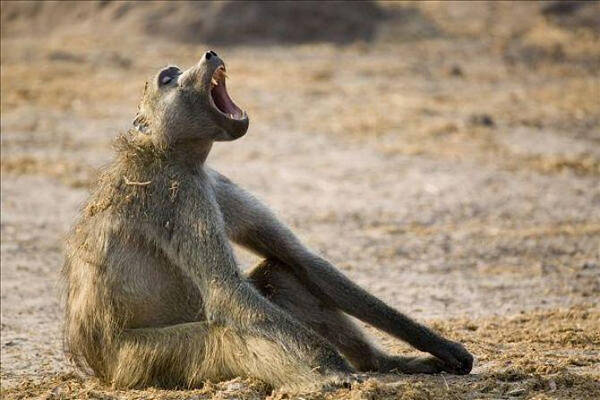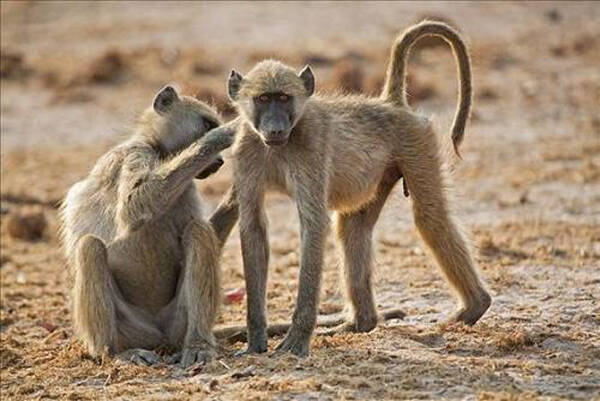Papio cynocephalus
IUCN
LCBasic Information
Scientific classification
- name:Papio cynocephalus
- Scientific Name:Papio cynocephalus,Yellow Baboon
- Outline:Primates
- Family:M.family Baboon
Vital signs
- length:97-120cm
- Weight:12-25kg
- lifetime:About 20 years
Feature
The overall color of the fur is brown, mostly tan, but some parts also have black tones.
Distribution and Habitat
Distributed in Angola, Democratic Republic of Congo, Ethiopia, Kenya, Malawi, Mozambique, Somalia, Tanzania and Zambia. Inhabits grasslands or forest edges in Africa.
Appearance
The head and body length of the grassland baboon is about 97-120 cm, the tail length is 40-60 cm, the male weight is about 21-25 kg, and the female weight is about 12-14 kg. The fur is yellowish brown (it varies slightly depending on the habitat). The head protrudes forward, and there are obvious body differences between males and females.
Steppe baboons are highly sexually dimorphic. There are 32 teeth. Males have large canine teeth, while females have much smaller teeth. There are three subspecies, and body shape and skull size, as well as the texture of their fur, vary significantly depending on the geographical location of their distribution. Larger in size, second only to the orangutan among primates, it has a thick and long head, a protruding snout, small ears, prominent eyebrow arches, deep-set eyes, long and pointed canine teeth, and cheek pouches; a stout body and equal-length limbs , short and thick, adapted to ground activities; there are brightly colored calluses on the
Details
Papio cynocephalus (scientific name: Papio cynocephalus), also known as Yellow Baboon, has three subspecies.

Grassland baboons are diurnal animals that live in groups. Each group usually has 30-60 individuals. The group consists of multiple males and multiple females, and any male has the possibility of mating with any female. This leads to fierce competition between males, and males often fight for mating rights. Grassland baboons determine each other's hierarchy by fighting, and only high-ranking male baboons can mate with female baboons in estrus. These social animals have other factors that affect the success of male mating. For example, males may subvert the normal dominance hierarchy and form alliances. Two males join forces as an alliance, and these males may be able to get fixed mating with females and succeed. Such alliances are mutual, and usually older males achieve their goals through mutual communication of rights and interests in very familiar groups.
Grassland baboons generally move on the ground during the day, are good at climbing rocks, and have the ability to climb trees. They are social animals that like to live in groups, sometimes forming large groups of hundreds of individuals, each of which is composed of several families. If there is sufficient food source, the large group will automatically break up and form some stable small groups. Each family is led by the strongest, most sturdy, and most beautiful male beast in the group. The size and sharpness of the male beast's canine teeth are important criteria for whether he can serve as the leader. Other members of the family include several underage male beasts of lower status, several female beasts, and cubs. The position of the leader is hard-won and not a lifetime system. Once a smarter and stronger male beast appears in the group, he will challenge the position of the leader. After a fight, the winner can continue to serve as the leader.

In the baboon group, the social hierarchy is very strict, which is caused by the survival competition of the law of the jungle in nature. In order to avoid unnecessary cannibalism and fighting within the group, unite to resist the enemy and ensure the smooth growth and development of the offspring, the members of the group naturally formed a hierarchical psychology with their own characteristics. The status of each individual in the group is determined by its ability, charm, size, strength, gender, age and other factors. The members of the community usually live in harmony and share the joys and sorrows of life, but the division of labor is also very clear. The leader has the highest status in the group, and the entire community must obey its command. It can give orders to members of the group, give priority to food, occupy female animals in estrus at will, and even mediate and adjudicate disputes between members. As long as it roars, other members will immediately bow their heads and obey; other members must show obedience when passing by the leader, and violators will be severely punished; when resting and eating, the leader must sit in the middle, etc. Female animals that have just given birth and their cubs also have a higher status in the group, and they are specially cared for and protected in terms of movement and feeding. Even when playing, female animals with cubs will not be attacked by other members. When the group moves, the leader often leads the team in front, followed by females and young males, females with cubs in the middle, and other stronger males in the rear. Each group occupies a large territory and travels around the territory. Every day, they mostly go out along a fixed route to move around, forage for food and drink water, and return to a fixed forest to roost at night.
The grassland baboons are wild and often fight in groups. If they encounter an intruder in the territory, the leader often takes the lead and rushes to the front, followed by other members. They are all like fierce and tenacious soldiers, roaring loudly, throwing stones at the intruder, or biting with sharp canine teeth.
Although they are often considered frugivores, savannah baboons are omnivores, but are actually dietary generalists. They eat pods, grasses, sedges, seeds, fruits, roots, leaves, buds, bark, flowers, insects, and meat. They also hunt rabbits and vervet monkeys.

Females have a 32-day estrus period, but the length of the cycle varies between individuals and groups. The differences stem from status in the group and nutritional differences between populations, and may also reflect underlying genetic differences. During ovulation, females have obvious swelling of the genital skin, which reminds males that they are in a mating state and increase their attractiveness. At this time, males will initiate mating, with mating times of 1 to 6 times per hour. When females become pregnant, the pericallus turns red and they no longer mate. This alerts them to their reproductive state. Gestation lasts about 175-181 days, and females give birth to one offspring per litter, weighing about 854 grams. Newborns have black or red fur, depending on the subspecies. Newborns are easily distinguished from larger young baboons. The young is completely dependent on its mother's milk for the first few months, until it begins to eat solid food, is weaned, and is able to walk on its own. The young are weaned at about 1 year old. Adult females lose a lot of weight while nursing. Females reach sexual maturity at 5-6 years old, signaled by menarche or, in some cases, first pregnancy. Male puberty varies more, reaching sexual maturity at 4-7 years old. 70 to 97% of males leave the family group and move elsewhere before reaching sexual maturity. Although females can usually remain in the group they were born in for their entire lives, some females have been observed to move to new groups.
The savannah baboon is hunted locally as an important source of protein, especially in densely populated areas of central Africa, where hunting pressure has increased. In addition, the continued destruction of natural habitats for agricultural use has reduced the number of areas available for foraging and habitat, which has led to the species' forced attacks on crops, and people have hunted it as a pest. There have been a number of accidental deaths on the road due to traffic accidents and exports as a subject of medical research, which has led to a decline in the number of this species. Overall, this species remains widespread and common throughout its range.
Listed in the IUCN Red List of Primates, ver.: 2008 - Low Concern (LC).
Protect wild animals and stop eating game.
Maintaining ecological balance is everyone's responsibility!








